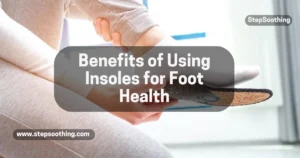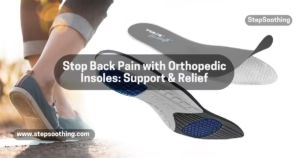Our feet are the foundation of our bodies, supporting us through every step of our lives. Yet, foot health is often overlooked until problems arise. Insoles, often underestimated but highly effective, play a crucial role in maintaining foot health and overall well-being. In this article, we’ll explore the numerous benefits of using insoles and why they should be an essential part of everyone’s footwear arsenal.

Importance of Foot Health
Before delving into the benefits of insoles, it’s important to understand the significance of foot health. Our feet bear the weight of our bodies and facilitate movement, making them essential for daily functioning.
However, conditions such as plantar fasciitis, flat feet, and heel spurs can impede foot health and lead to chronic pain and discomfort, affecting our quality of life.
What Are Insoles?
Insoles, also known as shoe inserts or footbeds, are inserts placed inside shoes to provide additional support, cushioning, and comfort. They come in various types, including arch support, cushioning, and orthotic insoles, each designed to address specific foot issues.
Insoles are typically made from materials such as gel, foam, or silicone, offering different levels of support and flexibility.

Benefits of Using Insoles
- Pain Relief: Insoles are praised for easing foot pain from conditions like plantar fasciitis, flat feet, and heel spurs. They offer extra support and cushioning, alleviating pressure and enhancing comfort in daily activities.
- Support and Stability: Proper alignment of the feet is essential for optimal biomechanical function. Insoles help improve foot posture and alignment, reducing the risk of overpronation (inward rolling) or supination (outward rolling). This enhanced stability not only prevents injuries but also promotes efficient movement patterns.
- Shock Absorption: The repetitive impact of walking or running can take a toll on our joints and muscles. Insoles with shock-absorbing properties cushion the feet, reducing the stress placed on bones and soft tissues. This not only prevents injuries such as stress fractures and shin splints but also enhances overall comfort during high-impact activities.
- Comfort: Whether you’re an athlete pushing your limits or someone on their feet all day at work, comfort is paramount. Insoles provide an additional layer of cushioning and support, reducing fatigue and muscle strain. This results in improved comfort and endurance, allowing you to perform at your best without discomfort holding you back.

Who Can get Benefit from Using Insoles?
Insoles are incredibly versatile and cater to a wide range of individuals:
- Athletes and Active Individuals: Whether you’re a runner, hiker, or dancer, insoles can enhance performance and reduce the risk of injury.
- People with Specific Foot Conditions: Individuals suffering from conditions such as plantar fasciitis, arthritis, or flat feet can find relief and support with the right pair of insoles.
- Those Who Stand or Walk for Prolonged Periods: Professionals in occupations that require long hours on their feet, such as healthcare workers or retail employees, can benefit from the added comfort and support of insoles.
- Anyone Seeking Improved Comfort in Footwear: Even if you don’t have specific foot issues, insoles can enhance the comfort of your shoes, making every step a pleasure.

Tips for Choosing the Right Insoles
- Consider Your Foot Type and Arch Height: Different insoles cater to different foot types, so it’s essential to choose one that suits your specific needs.
- Evaluate Your Foot Problems and Needs: Whether you need extra arch support or cushioning for heel pain, there’s an insole designed to address your concerns.
- Ensure Proper Fit and Size: Insoles should fit comfortably inside your shoes without crowding or slipping. Take accurate measurements and try on different options to find the perfect fit.
- Seek Professional Advice: If you’re unsure which insoles are right for you, consult a podiatrist or orthopedic specialist for personalized recommendations.
Conclusion
Insoles are not merely accessories; they are essential tools for maintaining foot health and enhancing overall well-being. By providing pain relief, support, shock absorption, and comfort, insoles empower individuals to lead active and fulfilling lives without the limitations of foot discomfort. Investing in quality insoles is an investment in your health and happiness, ensuring that every step you take is a step towards a brighter, more comfortable future.
Frequently Asked Questions
Q1. Is it good to wear insoles?
Yes, it is good to wear insoles for several reasons. Insoles provide extra cushioning and arch support, help correct foot alignment issues, reduce pressure on the feet, absorb shock impact, and can relieve foot pain from conditions like plantar fasciitis. Wearing proper insoles is beneficial for comfort, support, injury prevention and managing foot problems.
Q2. Do insoles actually work?
Yes, research shows that insoles are effective at reducing foot pain, preventing injuries, correcting biomechanical abnormalities like overpronation, and improving comfort and shock absorption. Custom orthotic insoles made specifically for an individual’s foot issues provide maximum benefits.
Q3. How long should you wear insoles?
It’s recommended to break in new insoles slowly, wearing them only 1-2 hours the first 1-2 days. Gradually build up to wearing the insoles full-time. Give your feet a break with 1-2 hours without insoles daily. Replace insoles every 6-12 months or when they appear worn.
Q4. How do I know if I need insoles?
It’s recommended to break in new insoles slowly, wearing them only 1-2 hours the first 1-2 days. Gradually build up to wearing the insoles full-time. Give your feet a break with 1-2 hours without insoles daily. Replace insoles every 6-12 months or when they appear worn.
Q5. Do insoles hurt at first?
Mild soreness is typical as your feet adjust to the new support and alignment from insoles. If pain persists beyond mild discomfort or lasts more than a few days, the insoles may not fit well or suit your needs. Consult a specialist to find proper alternatives.
Q6. What happens if you don’t wear insoles?
Going without proper insoles can lead to foot fatigue and pain, poor shock absorption, inadequate arch support, misalignment issues causing pain elsewhere like the knees and back, increased injury risk, development of foot conditions like plantar fasciitis and arthritis, uneven shoe wear and discomfort.
For more information on insoles, check out Introduction to Insoles, Types of Insoles & 5 Debunking Myths About Insoles and Orthotics. If you’re interested in a How to Choose the Right Insoles, explore our guide here.



